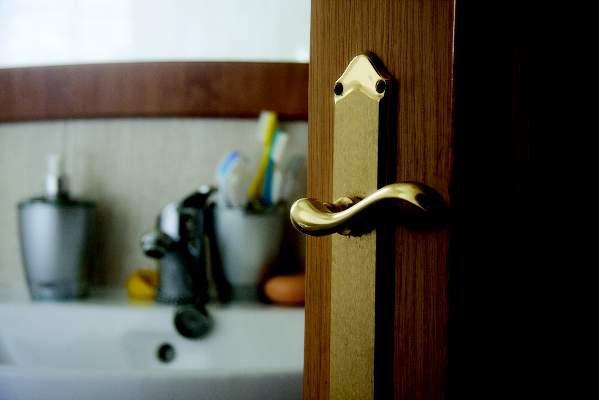User login
MIAMI BEACH – Patients with recurrent methicillin-resistant Staphylococcus aureus skin infections should be advised to address their environment, according to Dr. Theodore Rosen.
Toilets, telephones, hairbrushes, and bathroom sink and door handles are particular culprits in harboring MRSA, Dr. Rosen, professor of dermatology at Baylor College of Medicine, Houston, said at the South Beach Symposium.
That was the finding of a recent prospective longitudinal study looking at households in Los Angeles and Chicago with at least one index case of S. aureus skin infection, he said.
Samantha J. Eells of the Los Angeles Biomedical Research Center at Harbor-UCLA Medical Center, Torrance, Calif., and her colleagues enrolled 346 households of adults and children with such infections. Household fomites were surveyed for contamination at baseline and 3 months, and all isolates underwent genetic typing.
Nearly half (49%) of households were contaminated with S. aureus at baseline, and 51% of the 304 that completed follow-up were contaminated at 3 months. Of those with a USA300 MRSA body infection isolate, 58% and 63% had environmental contamination with an indistinguishable MRSA strain at baseline and at 3 months, respectively, the investigators found (Infect. Control. Hosp. Epidemiol. 2014;35:1373-82).
Numerous environmental locations were contaminated up to 3 months after the index case, but among the most common locations with MRSA contamination, with 7%-8% affected among the study households, were toilets, landline phones, index subjects’ hairbrushes, and bathroom sink and door handles. Other areas with contamination detected were children’s toys, television remote controls, kitchen counters, and kitchen sink handles.
“We found that an index subject’s infection isolate frequently persisted for at least 3 months, suggesting that it potentially serves as a reservoir that places all household members at risk for future S. aureus infections. While multiple S. aureus strain types were recovered from some households, the index subject’s infection strain persisted in more than 50% of households after 3 months,” the investigators wrote.
The findings, in the context of the high prevalence of body colonization found in the community-based population, suggests that successful outpatient decolonization may require not only eradication of nasal, skin, and oropharyngeal colonization, but also of environmental contamination, they said.
So not only can patients get MRSA from family members, sex partners, dogs and cats, and raw food sold in grocery stores, as shown in prior studies, they can also get it from the household environment, Dr. Rosen said.
“If you’re doing everything else [to eradicate colonization], you need to make sure someone who is having recurring MRSA outbreaks basically cleans up their environment,” he said.
Dr. Rosen reported having no disclosures.
MIAMI BEACH – Patients with recurrent methicillin-resistant Staphylococcus aureus skin infections should be advised to address their environment, according to Dr. Theodore Rosen.
Toilets, telephones, hairbrushes, and bathroom sink and door handles are particular culprits in harboring MRSA, Dr. Rosen, professor of dermatology at Baylor College of Medicine, Houston, said at the South Beach Symposium.
That was the finding of a recent prospective longitudinal study looking at households in Los Angeles and Chicago with at least one index case of S. aureus skin infection, he said.
Samantha J. Eells of the Los Angeles Biomedical Research Center at Harbor-UCLA Medical Center, Torrance, Calif., and her colleagues enrolled 346 households of adults and children with such infections. Household fomites were surveyed for contamination at baseline and 3 months, and all isolates underwent genetic typing.
Nearly half (49%) of households were contaminated with S. aureus at baseline, and 51% of the 304 that completed follow-up were contaminated at 3 months. Of those with a USA300 MRSA body infection isolate, 58% and 63% had environmental contamination with an indistinguishable MRSA strain at baseline and at 3 months, respectively, the investigators found (Infect. Control. Hosp. Epidemiol. 2014;35:1373-82).
Numerous environmental locations were contaminated up to 3 months after the index case, but among the most common locations with MRSA contamination, with 7%-8% affected among the study households, were toilets, landline phones, index subjects’ hairbrushes, and bathroom sink and door handles. Other areas with contamination detected were children’s toys, television remote controls, kitchen counters, and kitchen sink handles.
“We found that an index subject’s infection isolate frequently persisted for at least 3 months, suggesting that it potentially serves as a reservoir that places all household members at risk for future S. aureus infections. While multiple S. aureus strain types were recovered from some households, the index subject’s infection strain persisted in more than 50% of households after 3 months,” the investigators wrote.
The findings, in the context of the high prevalence of body colonization found in the community-based population, suggests that successful outpatient decolonization may require not only eradication of nasal, skin, and oropharyngeal colonization, but also of environmental contamination, they said.
So not only can patients get MRSA from family members, sex partners, dogs and cats, and raw food sold in grocery stores, as shown in prior studies, they can also get it from the household environment, Dr. Rosen said.
“If you’re doing everything else [to eradicate colonization], you need to make sure someone who is having recurring MRSA outbreaks basically cleans up their environment,” he said.
Dr. Rosen reported having no disclosures.
MIAMI BEACH – Patients with recurrent methicillin-resistant Staphylococcus aureus skin infections should be advised to address their environment, according to Dr. Theodore Rosen.
Toilets, telephones, hairbrushes, and bathroom sink and door handles are particular culprits in harboring MRSA, Dr. Rosen, professor of dermatology at Baylor College of Medicine, Houston, said at the South Beach Symposium.
That was the finding of a recent prospective longitudinal study looking at households in Los Angeles and Chicago with at least one index case of S. aureus skin infection, he said.
Samantha J. Eells of the Los Angeles Biomedical Research Center at Harbor-UCLA Medical Center, Torrance, Calif., and her colleagues enrolled 346 households of adults and children with such infections. Household fomites were surveyed for contamination at baseline and 3 months, and all isolates underwent genetic typing.
Nearly half (49%) of households were contaminated with S. aureus at baseline, and 51% of the 304 that completed follow-up were contaminated at 3 months. Of those with a USA300 MRSA body infection isolate, 58% and 63% had environmental contamination with an indistinguishable MRSA strain at baseline and at 3 months, respectively, the investigators found (Infect. Control. Hosp. Epidemiol. 2014;35:1373-82).
Numerous environmental locations were contaminated up to 3 months after the index case, but among the most common locations with MRSA contamination, with 7%-8% affected among the study households, were toilets, landline phones, index subjects’ hairbrushes, and bathroom sink and door handles. Other areas with contamination detected were children’s toys, television remote controls, kitchen counters, and kitchen sink handles.
“We found that an index subject’s infection isolate frequently persisted for at least 3 months, suggesting that it potentially serves as a reservoir that places all household members at risk for future S. aureus infections. While multiple S. aureus strain types were recovered from some households, the index subject’s infection strain persisted in more than 50% of households after 3 months,” the investigators wrote.
The findings, in the context of the high prevalence of body colonization found in the community-based population, suggests that successful outpatient decolonization may require not only eradication of nasal, skin, and oropharyngeal colonization, but also of environmental contamination, they said.
So not only can patients get MRSA from family members, sex partners, dogs and cats, and raw food sold in grocery stores, as shown in prior studies, they can also get it from the household environment, Dr. Rosen said.
“If you’re doing everything else [to eradicate colonization], you need to make sure someone who is having recurring MRSA outbreaks basically cleans up their environment,” he said.
Dr. Rosen reported having no disclosures.

